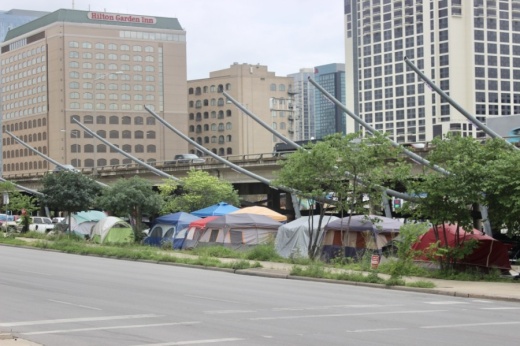Based on ECHO's estimate, 3,160 people were identified experiencing homelessness as of this January, including 2,238 living unsheltered—sleeping on the streets or other locations outside of established shelters and housing. A total of 922 was tracked in shelters, including just over 700 in traditional shelters and around 200 in Austin's noncongregate Protection Lodges established due to COVID-19. ECHO's first snapshot of the county's homeless population released in 2021 uses a new methodology compared to its previous annual point-in-time counts, or surveys conducted in person over the course of a single day. The process involved pulling from the local Homeless Management Information System—a client information database shared between homeless service providers—with data tabulated as of Jan. 28 and reflecting the number of unsheltered people and those seeking services over the previous 180 days.
ECHO Vice President Sarah Duzinski said the nonprofit compiled its figures this year using HMIS client information due both to the homeless population's higher risk of COVID-19 complications and a shortage in count volunteers that may have affected the count's accuracy.
"Our homeless response system staff were stretched very thin due to COVID-19 emergency response, and we knew that a lack of volunteer surveyors could lead to an undercount," Duzinski said.
ECHO also used the HMIS strategy to create new single-day estimates for January 2019 and January 2020 as those years' point-in-time counts are not comparable to the new data-based figures. Those estimates show just over a 1% drop in the Austin and Travis County homeless count since 2020, including a 1.06% drop in the unsheltered population and 1.07% drop in the sheltered category between traditional and ProLodge shelters.
ECHO also released HMIS-based estimates of homeless housing assistance in the county over the past several years. While the figures did not include a midyear estimate for 2021 housing efforts, the data shows a pattern of increased client housing by several hundred annually between 2017-20. According to ECHO's HMIS data, Austin and Travis County last year saw more than 1,000 clients placed into short-term permanent housing through rapid rehousing efforts and 187 clients with disabilities placed into subsidized permanent supportive housing. The 1,879 total clients housed locally in 2020 were around 8% higher than the 2019 total and more than 40% above 2017 levels.
The May report from ECHO also highlighted the representational disparity between Travis County's overall demographics and several subgroups of the county's homeless population. For example, 72% of the county is white, while only 55% of the homeless population is; Travis County's population is around 8% Black, while the share of its Black homeless population sits more than four times higher at 37%. The demographic breakdown also demonstrates the stark overrepresentation of people with disabilities among the homeless. Although fewer than 1 in 10 Travis County residents are disabled, 69% of those experiencing homelessness are also living with disabilities. That disparity can be tracked across living situations as well. Per ECHO, 71% of the county's unsheltered population, 51% of its sheltered population and 90% of those in ProLodges are disabled.
While ECHO's 2021 estimates were shifted away from in-person interactions, the nonprofit's Executive Director Matt Mollica said conditions over the past year have also allowed service providers to better connect with clients in the community.
Austin's previously rolled-back camping ban and federal pandemic guidance against clearing homeless encampments led to the prevalence of homeless individuals, tents and camps on the city's streets, he said, making individuals more accessible. That situation will likely change through the latter half of this year as camping ban enforcement takes effect, making future counts and client support potentially more difficult.
"What we know about what will happen now is once tickets start piling up, you’re going to be focused more on handling things to make sure that they don't have warrants, to take care of any potential criminal trespassing or ticket charges they might have," Mollica said. "It just kind of shifts the focus of the work away from ... permanent housing, a focus on engaging in permanent solutions to end homelessness, and creates more of a day-to-day crisis response."





